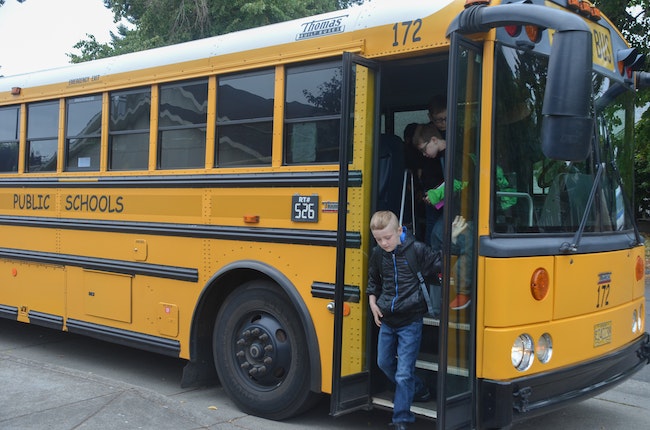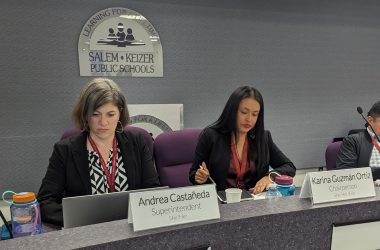 Students get off the bus for the first day of school at Bush Elementary. (Rachel Alexander/Salem Reporter)
Students get off the bus for the first day of school at Bush Elementary. (Rachel Alexander/Salem Reporter)
Salem-Keizer students improve their reading and math more than most U.S. students over the course of their education, according to a nationwide study by Stanford University.
But they still remain behind their peers across the U.S. on tests from third to eighth grade, the study found.
The study, called the Educational Opportunity Project, is the first of its kind to gather test scores from students in every U.S. school district over nearly a decade, providing a national picture of how public schools perform.
[Keep local news alive in Salem – subscribe today]
The findings echo what Salem-Keizer district leaders have said for years to explain poor local test scores: local students start school behind their peers across Oregon and in the U.S. on reading and writing, but improve more over the course of their schooling.
“They make more gains than most other kids who are experiencing poverty in the United States,” said assistant superintendent Kraig Sproles, after reviewing the Stanford data.
Sean Reardon, the Stanford researcher leading the project, said they looked at both test scores and student growth to give a fuller picture of school performance.
People tend to view test scores as a measure of school quality, but he said that view is too simplistic, especially in elementary school.
“What causes the low test scores is that children have relatively low educational opportunities to learn before they get to school,” he said. “Those low scores may have more to do with family resources, available preschool, things like that.”
Student improvement, he said, is a better indicator of school quality, because it shows how much students gain once they’re in school.
(Map from the Educational Opportunity Project/Stanford University)
Year over year, Salem-Keizer students improve about 16% more than the U.S. average. Compared to districts with similar poverty rates, it’s 19% more than the average.
Yet the average Salem-Keizer elementary and middle-schooler remains about half a grade behind their peers across the U.S.
That means the district needs to improve, Sproles said.
“You can’t rest on that because kids need to grow, but they need to grow at a rate where they catch up,” Sproles said. “Those teachers need to teach like their hair’s on fire to be able to move the dial for those kids.”
The study also examined gaps between groups of students.
In Salem-Keizer, white students test on average two grade levels above their Hispanic and black peers.
But Hispanic students improve more year-over-year than their white peers, while black students improve less, meaning that gap widens over time.
Beaverton and Portland public schools have larger gaps between white and Hispanic students, about three grades on average.
Learn how we do our work at Salem Reporter – read our principles.
Reporter Rachel Alexander: [email protected] or 503-575-1241.

Rachel Alexander is Salem Reporter’s managing editor. She joined Salem Reporter when it was founded in 2018 and covers city news, education, nonprofits and a little bit of everything else. She’s been a journalist in Oregon and Washington for a decade. Outside of work, she’s a skater and board member with Salem’s Cherry City Roller Derby and can often be found with her nose buried in a book.









